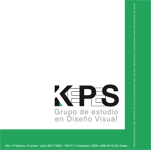Autores/as
Resumen
En el presente artículo se comparten algunos de los resultados obtenidos en la investigación “La fotografía como medio para el desarrollo de la alfabetidad visual” en la cual se analizaron diferentes estrategias para potenciar el desarrollo de la alfabetidad visual y el pensamiento crítico en estudiantes del programa de diseño gráfico de la Universidad Autónoma de Aguascalientes (México). La alfabetización visual alude a la capacidad de las personas de interpretar y generar imágenes a partir del estudio de los componentes que constituyen el lenguaje visual; competencia que en sí misma es un insumo fundamental en las prácticas dentro de las aulas de diseño, convirtiéndose en un ítem relevante para la investigación y la cualificación de sus profesionales.
El artículo muestra uno de los laboratorios implementados donde los estudiantes de tercer año del programa de diseño gráfico, luego de leer el capítulo El Medio es el Mensaje de Marshall McLuhan, visualizaron uno de los conceptos del texto; imagen que fue alojada en una plataforma virtual para su discusión en clase.
Entre los hallazgos, el lector conocerá la síntesis del análisis de cuatro de las 27 imágenes realizadas, lo que permite apreciar, entre otras cosas, que los estudiantes necesitan desarrollar capacidades argumentativas afines con los principios del pensamiento crítico, además, en su ejercicio proyectual la interpretación de conceptos debe ser concordante con los valores activos de su entorno, lo que posibilita la generación de productos que atiendan a las exigencias contextuales. A modo de conlcusión, se establece que la decodificación reflexiva ropia de la alfabetización visual y los procedimientos de interpretación y representación del conocimiento, inherentes al pensamiento crítico, deberían ser asumidas como estrategias de enseñanza–aprendizaje en los cursos que configuran el plan de estudio de la licenciatura en diseño gráfico.
Palabras clave
Citas
Berger, J. (1972). Ways of Seeing. London: Penguin Books.
Burn, A. & Durran, Ja. (2007). Media Literacy in Schools. Practice, Production and Progression. London: Paul Chapman Publishing.
Center for Ecoliteracy. Recuperado de: https://www.ecoliteracy.org/about
Chamorro-Koc, M. Scott, A. & Coombs, G. (2015). Bombs Away: Visual thinking and students’ engagement in design studios contexts. Design and Technology Education: an International Journal, 20(1).
De la Cuesta, C. y Otálvaro, C. (2015). La reflexividad y la autocrítica como fundamentos de la investigación cualitativa. Salud Pública, 33(1).
Dussán, C. et al. (2016). Perspectiva de los egresados sobre la pertinencia académica del Programa de Diseño Visual. Revista Kepes. 13(13), pp. 9-28.
IVLA. (2012). What is Visual Literacy? International Visual Literacy Association, Recuperado de http://ivla.org/new/what-is-visual-literacy-2/
Kincheloe, J., McLaren, P. (2005). Rethinking Critical Theory and Qualitative Research. En Denzin, N. y Lincoln, Y. The Sage Handbook of Qualitative Research: California: Thousand Oaks, 303-342.
López-León, R. (2015). Primera aproximación al concepto de visual literacy y su importancia en la educación del arte y diseño. En C. Villagómez & J. Saldaña, Estudios Críticos en Arte y Diseño. Guanajuato: Universidad de Guanajuato.
Martínez, C. (2015). El compromiso interpretativo, un aspecto ineludible en la investigación cualitativa. Salud Pública, 33(1).
McLuhan, M. (1996). El medio es el mensaje. Comprender los medios de comunicación. Las extensiones del ser humano. Barcelona: Paidós.
NCREL & METIRI, (2003). enGauge 21st Century Skills: Literacy in the Digital Age, North Central Regional Educational Laboratory and the Metiri Group: California. Recuperado de http://pict.sdsu.edu/engauge21st.pdf el 10 diciembre 2014.
Riddle, J. (2009). Engaging the Eye Generation, Visual Literacy Strategies in the K-5 Classroom, Stenhouse Publishers. Recuperado de http://booksgreatchoice.com/getbook/p306781/?id=30
Scriven, M. & Paul, R. (1987). Defining Critical Thinking. The Critical Thinking Community. Recuperado de http://www.criticalthinking.org/pages/definingcritical-thinking/766
Steiner, C. & Perry, P. (1997). Achieving Emotional Literacy. London: Bloomsbury.
Stokes, S. (2001). Visual Literacy in Teaching and Learning: A Literature Perspective. Electronic Journal for the Integration of Technology in Education 1(1). Recuperado de http://ejite.isu.edu/Archive.html
Taboada, M. & Coombs, G. (2013). Liminal moments: designing, thinking and learning. In J.B. Reitan, I. Digranes, & Nielsen (Eds.), DRS Cumulus 2013: Design Learning for Tomorrow – Design Education from Kindergarten to PhD. Oslo: LM.
Taylor, S.J. & Bogdán, R. (1987). Introducción a los métodos cualitativos de investigación. Barcelona: Paidós.
Villa, G. et al. (2016). Perspectiva de los empleadores sobre la pertinencia académica del Programa de Diseño Visual. Revista Kepes 13 (13), pp. 29-49.

 pdf
pdf
 FLIP
FLIP























